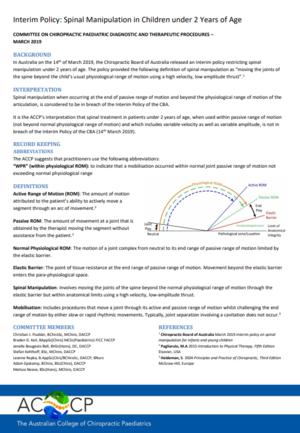| Australian College of Chiropractic Paediatrics |
Interim Policy: Spinal Manipulation in Children under 2 Years of Age
MARCH 2019
COMMITTEE ON CHIROPRACTIC PAEDIATRIC DIAGNOSTIC AND THERAPEUTIC PROCEDURES BACKGROUND In Australia on the 14th of March 2019, the Chiropractic Board of Australia released an interim policy restricting spinal manipulation under 2 years of age. The policy provided the following definition of spinal manipulation as “moving the joints of the spine beyond the child’s usual physiological range of motion using a high velocity, low amplitude thrust”.1 INTERPRETATION Spinal manipulation when occurring at the end of passive range of motion and beyond the physiological range of motion of the articulation, is considered to be in breach of the Interim Policy of the CBA. It is the ACCP’s interpretation that spinal treatment in patients under 2 years of age, when used within passive range of motion (not beyond normal physiological range of motion) and which includes variable velocity as well as variable amplitude, is not in breach of the Interim Policy of the CBA (14th March 2019). RECORD KEEPING ABBREVIATIONS The ACCP suggests that practitioners use the following abbreviations: DEFINITIONS Active Range of Motion (ROM): The amount of motion attributed to the patient’s ability to actively move a segment through an arc of movement.2 Passive ROM: The amount of movement at a joint that is obtained by the therapist moving the segment without assistance from the patient.2 Normal Physiological ROM: The motion of a joint complex from neutral to its end range of passive range of motion limited by the elastic barrier. Elastic Barrier: The point of tissue resistance at the end range of passive range of motion. Movement beyond the elastic barrier enters the para-physiological space. Spinal Manipulation: Involves moving the joints of the spine beyond the normal physiological range of motion through the elastic barrier but within anatomical limits using a high velocity, low-amplitude thrust. Mobilisation: Includes procedures that move a joint through its active and passive range of motion whilst challenging the end range of motion by either slow or rapid rhythmic movements.Typically, joint separation involving a cavitation does not occur.3 COMMITTEE MEMBERSChristian J. Fludder, BChiroSc, MChiro, DACCP REFERENCES1 Chiropractic Board of Australia March 2019 Interim policy on spinal manipulation for infants and young children |

